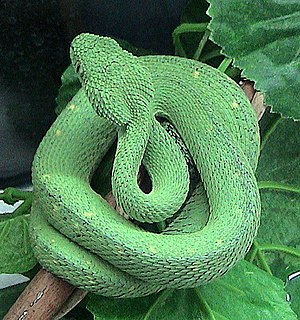Western bush viper
| Western bush viper | ||||||||||||
|---|---|---|---|---|---|---|---|---|---|---|---|---|

Western bush viper ( Atheris chlorechis ) |
||||||||||||
| Systematics | ||||||||||||
|
||||||||||||
| Scientific name | ||||||||||||
| Atheris chlorechis | ||||||||||||
| ( Pel , 1852) |
The western bush viper ( Atheris chlorechis ) is a species of viper from the subfamily of the real vipers and belongs to the genus of bush vipers ( Atheris ).
features
The western bush viper reaches a total length between 50 and 70 cm. The body is slightly stocky. The tail is designed as a grasping tail in adaptation to a climbing way of life, but is relatively short. The head is short, triangular in shape when viewed from above and clearly set off from the slender neck. The eye is large and has a pupil that slits vertically when exposed to light. The body color is pale green on top and darkens on the body sides towards the tail. At a distance of two to three centimeters, small, golden-yellow spots can be seen on the flanks. The ventral side is yellowish to greenish in color. Juvenile animals have yellow colored flanks and green spots. The scales on the head and body are elongated and give a shaggy appearance. The venom apparatus consists of venom glands located on the side of the skull (specialized salivary glands ) and movable fangs located in the anterior upper jaw ( solenoglyph tooth position).
Pholidosis
The pholidosis (scaling) shows the following characteristics:
- 9 to 12 upper lip shields ( supralabials ),
- 25 to 36 rows of strongly keeled trunk scales ( Scuta dorsalia ), elongated, protruding, with apical dimples and larger in the dorsal position than on the sides of the body,
- 154 to 165 abdominal shields ( scuta ventralia ), smooth and rounded,
- 52 to 62 under tail shields ( scuta subcaudalia ).
Systematics
The first description of Atheris chlorechis was made in 1852 by the Dutch colonial officials and naturalist Hendrik Severinus Pel under the name Vipera chlorechis . It is the type species of the genus Atheris Cope 1862. Currently (status: 2018) no subspecies are listed.
distribution
The distribution area includes areas in sub-Saharan Africa in Guinea , Sierra Leone , Liberia , Ivory Coast , Ghana , Togo , Nigeria and Cameroon . The habitat is represented by tropical rainforest. Finds were also documented at the edges of forests, rivers and on agricultural areas such as banana plantations. Populations from semi-arid regions are known from northeastern Nigeria .
Way of life
Atheris chlorechis leads a predominantly diurnal and climbing lifestyle. It is often found curled up in the foliage and branches of bushes, small trees and climbing plants at a height of a few meters, where it lies in wait for prey as a hide hunter . The grasping tail is often wrapped around smaller branches in two or three turns. Its camouflage makes it difficult to find. The range of prey includes small mammals , frogs , birds and small lizards . Reproduction takes place through ovoviviparia , i.e. co-giving birth. The litter of the young occurs mostly in the months of March and April and comprises six to nine young snakes. These measure around 13 to 15.5 cm at birth.
The species is not aggressive towards humans. Bite attacks usually only occur when provoked.
Snake venom
The poisonous secretion of Atheris chlorechis contains substances that affect hemostasis (procoagulants) and probably metalloproteases . In humans, bite accidents usually proceed without severe systemic intoxication . Local discomfort can be pain and swelling . Rare complications may result from damage to blood vessel walls and depletion of coagulation factors , and include consumption coagulopathy and hemorrhages . Furthermore, shock and secondary damage to the kidneys cannot be excluded. A specific antivenin is not available. The therapy of a poison bite is symptomatic. In the case of pronounced coagulopathy, replacement of coagulation factors may be indicated.
etymology
The specific epithet “chlorechis” comes from the Greek “chloros” (χλωρός) for “green” (based on the body color) and “echis” (ἔχις) for “viper”. The sometimes common trivial name "green bush viper" also refers to the body color, but can lead to confusion with the species Atheris squamigera , which is also called .
Danger
Populations of Atheris chlorechis can wildlife trade and deforestation be at risk of rainforests, the impact on the snake at the time: is assessed as not significant (as of 2018). Furthermore, numerous occurrences are known in areas that are under protection. The IUCN lists the species as not endangered (“least concern”) due to its large distribution area. Importation and keeping in captivity are rare. Offspring can be done in captivity.
Individual evidence
- ↑ a b Atheris chlorechis in The Reptile Database (accessed on July 20, 2018)
- ↑ a b IUCN Red List: Atheris chlorechis (accessed on July 20, 2018)
- ↑ a b University of Adelaide, Clinical Toxinology Resources: Atheris chlorechis (accessed July 20, 2018)
literature
- Ludwig Trutnau: Snakes in the Terrarium Vol. 2: Poisonous snakes . Verlag Ulmer, Stuttgart 1998, ISBN 3-800-1705-23 .
